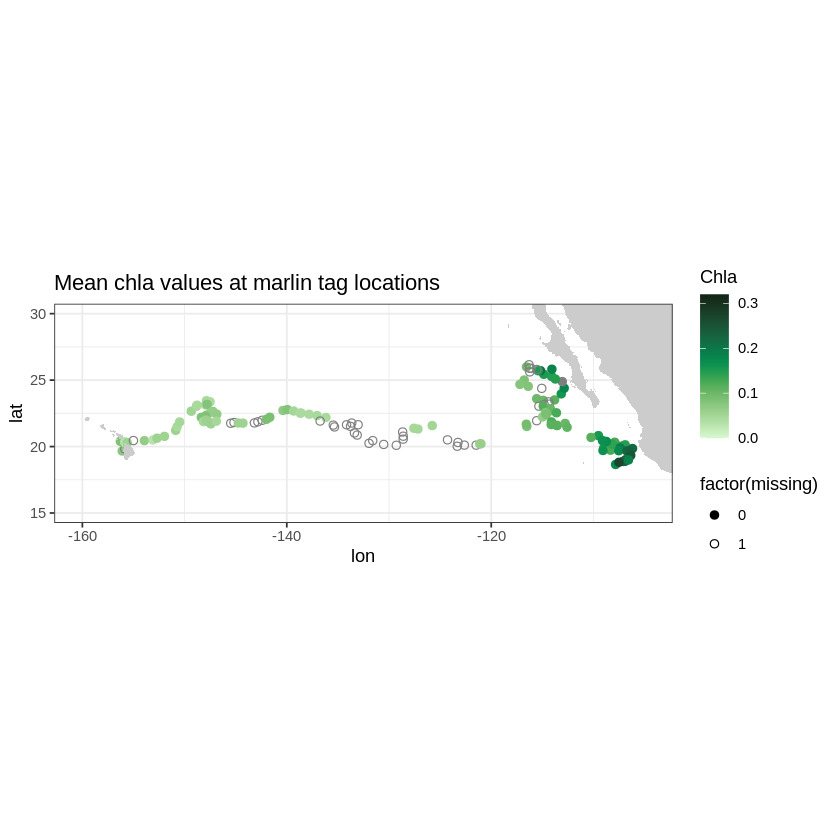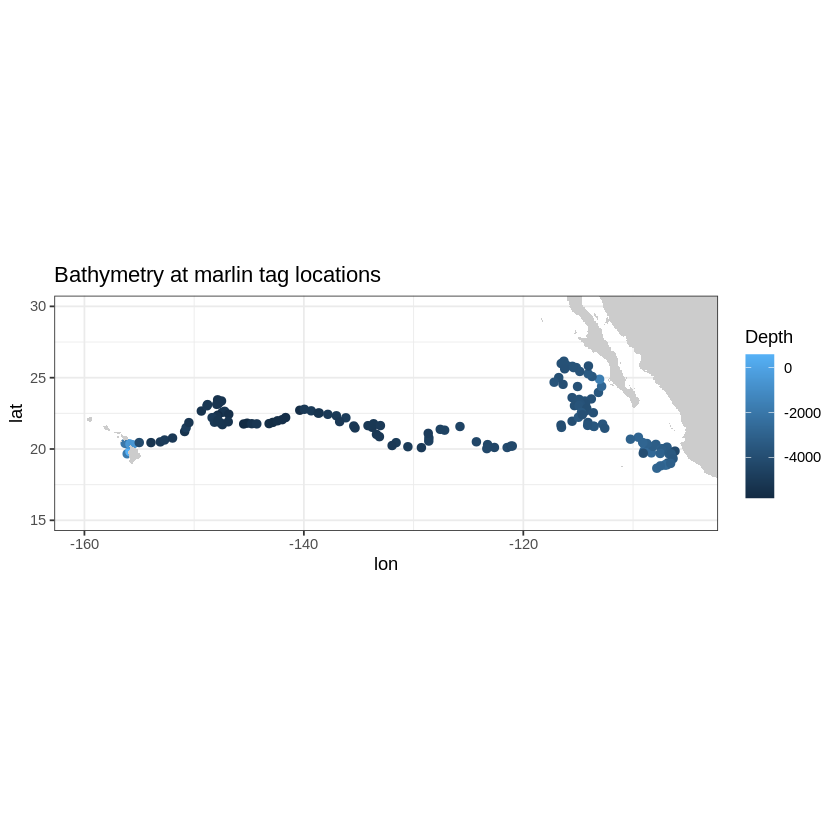Using the xtractomatic R package to track Pacific Blue Marlin#
Created: 2017-08-01
The xtractomatic package can be used to subset data from remote servers. From the GitHub README:
xtractomatic is an R package developed to subset and extract satellite and other oceanographic related data from a remote server. The program can extract data for a moving point in time along a user-supplied set of longitude, latitude and time points; in a 3D bounding box; or within a polygon (through time). The xtractomatic functions were originally developed for the marine biology tagging community, to match up environmental data available from satellites (sea-surface temperature, sea-surface chlorophyll, sea-surface height, sea-surface salinity, vector winds) to track data from various tagged animals or shiptracks
There are routines to extract data from a lon, lat, time track (like a drifter or glider trajectory), a 3D bounding box, or within a polygon. For this example let us use the built-in dataset for the tagged blue marlin fish in the Pacific Ocean (Marlintag38606).
library('xtractomatic')
str(Marlintag38606)
'data.frame': 152 obs. of 7 variables:
$ date : Date, format: "2003-04-23" "2003-04-24" ...
$ lon : num 204 204 204 204 204 ...
$ lat : num 19.7 19.8 20.4 20.3 20.3 ...
$ lowLon: num 204 204 204 204 204 ...
$ higLon: num 204 204 204 204 204 ...
$ lowLat: num 19.7 18.8 18.8 18.9 18.9 ...
$ higLat: num 19.7 20.9 21.9 21.7 21.7 ...
This is a “track-like” data set of the tagged marlin with lon, lat, time arrays.
tagData <- Marlintag38606
xpos <- tagData$lon
ypos <- tagData$lat
tpos <- tagData$date
Now we can extract, for example, SeaWiFS chlorophyll 8 day composite(swchla8day) data around the recorded tags to see if the marlin follow areas of high productivity to presumably find food.
Note the that xlen=0.2 and ylen=0.2 is the bounding latitude/longitude box (in decimal degrees) for finding the data around the desired positions
swchl <- xtracto("swchla8day", xpos, ypos, tpos = tpos, , xlen = .2, ylen = .2)
str(swchl)
'data.frame': 152 obs. of 11 variables:
$ mean chlorophyll : num 0.073 NaN 0.074 0.0653 0.0403 ...
$ stdev chlorophyll : num NA NA 0.00709 0.00768 0.02278 ...
$ n : int 1 0 16 4 7 9 4 3 0 6 ...
$ satellite date : chr "2003-04-19" "2003-04-27" "2003-04-27" "2003-04-27" ...
$ requested lon min : num 204 204 204 204 204 ...
$ requested lon max : num 204 204 204 204 204 ...
$ requested lat min : num 19.6 19.7 20.3 20.2 20.2 ...
$ requested lat max : num 19.8 19.9 20.5 20.4 20.4 ...
$ requested date : num 12165 12166 12172 12173 12174 ...
$ median chlorophyll: num 0.073 NA 0.073 0.0645 0.031 ...
$ mad chlorophyll : num 0 NA 0.00297 0.00741 0.0089 ...
Now we can use the maps and ggplot2 packages to plot the results.
library('ggplot2')
library('maps')
library('mapdata')
alldata <- cbind(swchl, tagData)
alldata$lon <- alldata$lon - 360
alldata$missing <- is.na(alldata$mean) * 1
colnames(alldata)[1] <- 'mean'
# set limits of the map
ylim <- c(15, 30)
xlim <- c(-160, -105)
# get outline data for map
w <- map_data("worldHires", ylim = ylim, xlim = xlim)
# plot using ggplot
myColor <- colors$algae
z <- ggplot(alldata,aes(x = lon, y = lat)) +
geom_point(aes(colour = mean, shape = factor(missing)), size = 2.) +
scale_shape_manual(values = c(19, 1))
z + geom_polygon(data = w, aes(x = long, y = lat, group = group), fill = "grey80") +
theme_bw() +
scale_colour_gradientn(colours = myColor, limits = c(0., 0.32), "Chla") +
coord_fixed(1.3, xlim = xlim, ylim = ylim) + ggtitle("Mean chla values at marlin tag locations")
We can do the same for topography data. Let’s use the ETOPO360 dataset to display the depth at the tag locations.
ylim <- c(15, 30)
xlim <- c(-160, -105)
topo <- xtracto("ETOPO180", tagData$lon, tagData$lat, xlen = .1, ylen = .1)
alldata <- cbind(topo, tagData)
alldata$lon <- alldata$lon - 360
colnames(alldata)[1] <- 'mean'
z <- ggplot(alldata, aes(x = lon,y = lat)) +
geom_point(aes(colour = mean), size = 2.) +
scale_shape_manual(values = c(19, 1))
z + geom_polygon(data = w, aes(x = long, y = lat, group = group), fill = "grey80") +
theme_bw() +
scale_colour_gradient("Depth") +
coord_fixed(1.3, xlim = xlim, ylim = ylim) + ggtitle("Bathymetry at marlin tag locations")
For more information and example on the other routines see the full example from the documentation at https://rmendels.github.io/Usingxtractomatic_3.4.0.nb.html
PS: note that R and all the xtractomatic dependencies are already included in the IOOS conda environment.




